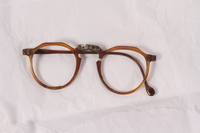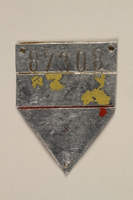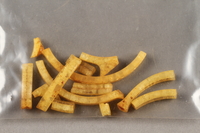Overview
- Description
- Identification cards and papers, correspondence, certificates, and documents relating to Karl and Eva Schlesinger before, during, and after the Holocaust.
- Credit Line
- United States Holocaust Memorial Museum collection, gift of Dave Schlesinger
Physical Details
- Genre/Form
- Identification documents. Letters. Certificates.
- Extent
-
1 folder
2 oversize folders
Rights & Restrictions
- Conditions on Access
- There are no known restrictions on access to this material.
- Conditions on Use
- Material(s) in this collection may be protected by copyright and/or related rights. You do not require further permission from the Museum to use this material. The user is solely responsible for making a determination as to if and how the material may be used.
Administrative Notes
- Holder of Originals
-
United States Holocaust Memorial Museum
- Legal Status
- Permanent Collection
- Provenance
- Donated to the United States Holocaust Memorial Museum in 2019 by Dave Schlesinger, son of Karl Schlesinger.
- Record last modified:
- 2023-02-24 14:38:46
- This page:
- https://collections.ushmm.org/search/catalog/irn710655
Download & Licensing
- In Copyright - Use Permitted
- Terms of Use
- This record is not digitized and cannot be downloaded online.
In-Person Research
- Request 7 Days in Advance of Visit
- Plan a Research Visit
-
Request in Shapell Center Reading Room
Bowie, MD
Contact Us
Also in Karl Schlesinger collection
The collection consists of a badge and eyeglasses, a photograph, and a postcard relating to the experiences of Karl Schlesinger in several concentration camps in Belgium, France, Germany, and Poland during the Holocaust and after the war in displaced persons camps in Germany. An accretion of post-war documents, certificates, identity card issued to Karl (Carl) Schlesinger. A second accretion of a pair of eyeglasses (broken) carried by Karl Schlesinger during WWII; identification cards and papers, correspondence, certificates, and documents relating to Karl and Eva Schlesinger during the Holocaust. Some of these materials may be combined into a single collection in the future.
Date: 1939 May-1945 June 13

Plastic eyeglass frames, temple and lenses worn by a Jewish concentration camp inmate
Object
Eyeglass frames, temple, and lenses worn by Karl Schlesinger while a prisoner in several concentration camps from May 1939, when he was 22, until April 1945. As he was processed for prison, a German civilian warned him not to wear his glasses so he hid them in his hands. The eyeglass bridge was repaired by a German civilian working in one camp. By May 1939, Karl had fled Nazi Germany for Belgium. He was imprisoned twice by the Belgians, first as an illegal Jewish refugee, then as a German spy. He was sent to a military hospital in France and when Germany occupied that country in June 1940, he was transferred to St-Cyprien and Gurs internment camps. In August 1942, Karl was deported to Trezbinia concentration camp, then to Auschwitz, where he was tattooed with 160304. In November 1943, he was sent to Warsaw to clean the ghetto after the failed uprising. When Soviet troops approached in July 1944, he was forced on a death march and sent by train to Dachau, then Allach. He was liberated on a train on April 29 in Starnberger See by an American tank division. He traveled to Feldalfing and other dp camps where he heard that his parents were alive in Berlin. After two tries, he illegally crossed into the Soviet sector to find them. Karl reunited with his parents, Philipp and Johanna, in Berlin that November.

Metal ID badge with number 87308 issued to a Jewish prisoner
Object
Shield shaped, metal identification badge with prisoner number 87308 issued to 27-year-old Karl Schlesinger in Dachau concentration camp in August 1944. It is painted yellow and red to identify Karl as a Jew. By May 1939, Karl had fled Nazi Germany for Belgium. He was imprisoned twice by the Belgians, first as an illegal Jewish refugee, then as a German spy. He was sent to a military hospital in France and when Germany occupied that country in June 1940, he was transferred to St-Cyprien and Gurs internment camps. In August 1942, Karl was deported to Trezbinia concentration camp, then to Auschwitz, where he was tattooed with 160304. In November 1943, he was sent to Warsaw to clean the ghetto after the failed uprising. When Soviet troops approached in July 1944, he was forced on a death march and sent by train to Dachau, then Allach. He was liberated on a train on April 29 in Starnberger See by an American tank division. He traveled to Feldalfing and other dp camps where he heard that his parents were alive in Berlin. After two tries, he illegally crossed into the Soviet sector to find them. Karl reunited with his parents, Philipp and Johanna, in Berlin that November.
Karl Schlesinger papers
Document
Postcard: form, completed by Karl Schelsinger in Feldafing displaced persons camp in Germany and addressed to Kurt Schlesinger in Palestine stating Karl is well, dated June 13, 1945, in three languages; photographic portrait of Karl: December 1945, Berlin, Germany




